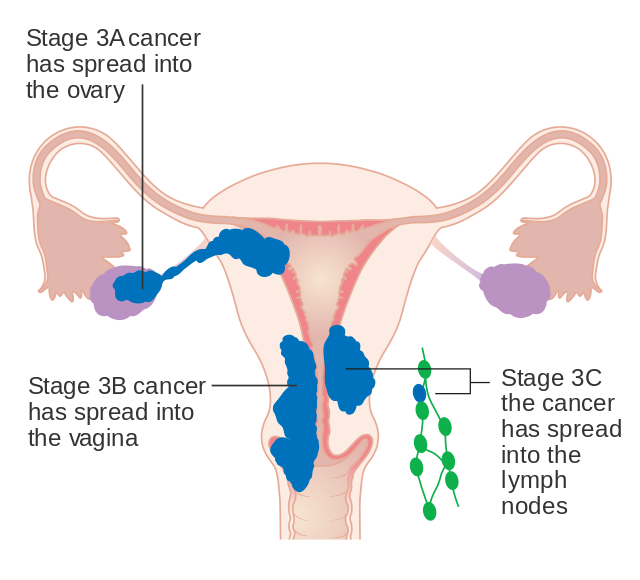Stage 3 Endometrial Cancer is cancer that began in the tissue lining of the uterus and has spread beyond the uterus and cervix, but has not spread beyond the pelvis.
Understanding Stage 3 Endometrial Cancer will help you partner with your doctors to make the best treatment choice for you.
Endometrial Cancer Stage 3 ICD 10 is C54.1.
Tap “Listen Now” for an easy-to-understand overview of Stage 3 Endometrial Cancer.
- Stage 3A Endometrial Cancer
- Stage 3B Endometrial Cancer
- Stage 3C Endometrial Cancer
Overview
A Stage 3A Endometrial Cancer diagnosis means that the cancer has spread to the outer layer of your uterus called the Serosa and/or it has spread to your ovaries as shown here on the top left. It also may have spread to nearby ligaments.
What Tests Will I Need and Why?
Blood and Imaging tests are done to understand your general health, confirm your diagnosis and determine your cancer stage.
Tissue analysis is also typically done through a biopsy to identify the cancer cell type, which is critical to finding the best treatment option for you.
If your treatment team has not already performed tests to determine your cancer’s features, please ask your doctor when these tests will be performed.
Re-read this summary as needed and then tap, “Compare My Treatment Options Now“. Our unique Comparison Page will help you understand your FDA-approved treatment options including, who can help you pay for your treatment, where and how each is given and what side-effects you may experience.

Cancer Research U.K. CC BY-SA 4
Overview
Stage 3B Endometrial Cancer means that the cancer has spread into your vagina or the tissue that surrounds your uterus called the Parametrium, the connective tissue and fat that surround your uterus and cervix.
What Tests Will I Need and Why?
Blood and Imaging tests are done to understand your general health, confirm your diagnosis and determine your cancer stage.
Tissue analysis is also typically done through a biopsy to identify the cancer cell type, which is critical to finding the best treatment option for you.
If your treatment team has not already performed tests to determine your cancer’s features, please ask your doctor when these tests will be performed.
Re-read this summary as needed and then tap, “Compare My Treatment Options Now“. Our unique Comparison Page will help you understand your FDA-approved treatment options including, who can help you pay for your treatment, where and how each is given and what side-effects you may experience.

Cancer Research U.K. CC BY-SA 4
Overview
Stage 3C Endometrial Cancer means that the cancer has spread from your uterus to nearby lymph nodes in your pelvis as shown here in green. In some cases, the cancer has spread to lymph nodes around your aorta which is the largest artery in your body responsible for carrying blood away from your heart.
What Tests Will I Need and Why?
Blood and Imaging tests are done to understand your general health, confirm your diagnosis and determine your cancer stage.
Tissue analysis is also typically done through a biopsy to identify the cancer cell type, which is critical to finding the best treatment option for you.
If your treatment team has not already performed tests to determine your cancer’s features, please ask your doctor when these tests will be performed.
Re-read this summary as needed and then tap, “Compare My Treatment Options Now“. Our unique Comparison Page will help you understand your FDA-approved treatment options including, who can help you pay for your treatment, where and how each is given and what side-effects you may experience.

Cancer Research U.K. CC BY-SA 4
Recommended Endometrial Cancer Videos

Endometrial Cancer In The Black Community
Brought To You By Black Health Matters

Endometrial Cancer Overview
CDC Did You Know Series

How Cancer Spreads
Metastatic = Advanced

Diagnosing Your Cancer
How Does a PET Scan Work?

Diagnosing Your Cancer
How Does a CT Scan Work?

Exercise! You Can Do It
Reducing Side Effects & More
Commonly Searched Questions
Stage 3 Endometrial Cancer Survival Rate
According to SEER data, Stage 3 Endometrial Cancer has a survival rate of 69.8%. For example, if the 5-year relative survival rate for a specific stage of endometrial cancer is 69.8%, it means that patients who have that cancer are, on average, about 69.8% as likely as patients who don’t have that cancer to live for at least 5 years after being diagnosed.
Source: Cancer.gov
Stage 3 Endometrial Cancer Treatment
Stage 3 endometrial cancers have spread outside of the uterus.
If the surgeon thinks that all visible cancer can be removed, a hysterectomy is done and both ovaries and fallopian tubes are removed. Sometimes women with stage 3 cancers need a radical hysterectomy.
Source: Cancer.org
Stage 3 Endometrial Cancer Symptoms
One of the most common symptoms of endometrial cancer is abnormal vaginal bleeding. This can include:
- changes in the length or heaviness of menstrual periods
- vaginal bleeding or spotting between menstrual periods
- vaginal bleeding after menopause
- pelvic pain
Source: Cancer.org
Stage 3 Endometrial Cancer Recurrence Rate
The overall prognosis for stage 3 endometrial cancer shows an outcome of 69.8% for the 5-year survival rate, and 37.5% of the patients still experience recurrence.
Source: PubMed.gov
Stage 3 Endometrial Cancer Definition
Stage 3 Endometrial cancer extends outside the uterus but remains confined to the pelvis. It is divided into 3 Stages. Stage IIIA cancers invade the lining of the pelvis or fallopian tubes or cancer cells can be found free in the pelvis. Stage IIIB cancer invades the vagina. Stage IIIC cancers invade the pelvic and/or para-aortic lymph nodes.
Source: Cancer.org
Stage 3 Endometrial Cancer Prevention
While specific prevention strategies for Stage 3 endometrial cancer, where the cancer has spread to nearby tissues and possibly lymph nodes, are not tailored to this advanced stage, general prevention strategies to reduce the risk of developing endometrial cancer include:
- Maintain a Healthy Weight: Obesity is a major risk factor for endometrial cancer.
- Manage Diabetes: Proper control of diabetes can help reduce cancer risk.
- Use Birth Control Pills: Oral contraceptives may lower the risk of endometrial cancer.
- Discuss Hormone Therapy Risks: If hormone replacement therapy is needed, consult your doctor about the associated risks.
Regular gynecological exams and monitoring can also aid in early detection and managing risk factors.
Source: Cancer.org





